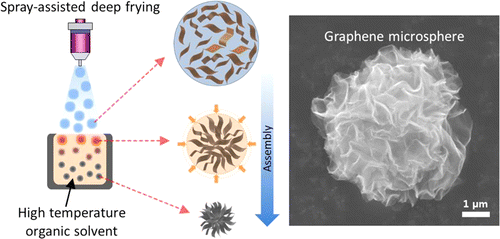In Korea, the work of materials scientists is making news worldwide this week, following publication of their article, "Spray-Assisted Deep-Frying Process for the In Situ Spherical Assembly of Graphene for Energy-Storage Devices," in Chemistry of Materials. Its eight authors used a spray of graphene oxide into hot solvent to form pom-pom-like particles suitable for electrodes and discussed the results of their spray-assisted deep-frying process. "A simple, spray-assisted method for the self-assembly of graphene was successfully demonstrated by using a high temperature organic solvent in a manner reminiscent of the deep-frying of food." Pratchi Patel, in Chemical & Engineering News, presented a detailed explanation of their accomplishments, saying they constructed round, pom-pom-like graphene microparticles by spraying the graphene oxide droplets into a hot solvent. Their process was like deep-frying. The technique could provide "a simple, versatile means to make electrode materials for batteries and supercapacitors, possibly leading to devices with improved energy and power densities."
Making graphene foams and aerogels is not new; there are groups who tried this out before, but results turned out to be unsuitable for electrodes because of bulk and irregularity and the carbon material's low density, according to co-author Sang-Hoon Park, Department of Materials Science and Engineering, Yonsei University.
Patel wrote that a few other groups made less bulky graphene nanospheres and microspheres using 3-D templates and techniques such as chemical vapor deposition and freeze-drying and the researchers took this second route. Here's the departure: While others made spheres looking like hollow balls or wads of crumpled paper, said Patel, the Korean team's particles resembled pom-poms, containing graphene nanosheets radiating out from the center. Park said the arrangement increased the exposed surface area of the graphene and created open nanochannels that can enhance charge transfer.
What do other scientists think about their approach? Patel reported that: Shu-Hong Yu, a chemist and nanoscientist at the University of Science & Technology of China, regarded the deep-frying technique as an important feature of their work. Compared with other methods for making 3-D graphene, it is "direct, simple, and much easier to scale up for industrial applications," he said, and another advantage was that the method allowed functional nanoparticles to be trapped directly into the microspheres to form nanocomposites.
Summing up, in the words of Engadget, the deep-frying process might be the ticket to better batteries in mobile devices. Graham Templeton of ExtremeTech puts the scientists' work in the bigger picture—battery technology, becoming one of the, if not the, weakest link in high-level technology.
"Modern" batteries don't just hold back consumer electronics through their large size, limited charge, low heat resistance, and hefty expense, they also cost us a lot of energy due to inefficiency," said Templeton. As for graphene, said Templeton, people already are getting jaded about it. "On the small scale, with extreme difficulty, graphene can be used to do seemingly anything, while on the practical scale, with anything less than physical research budgets to spend, seemingly nothing." That is where the contribution of the Korean scientists' work comes in. "Breakthroughs like this one, while specialized, are exactly what we need if the alleged super-material is ever going to come into its own."
More information: Spray-Assisted Deep-Frying Process for the In Situ Spherical Assembly of Graphene for Energy-Storage Devices, Chem. Mater., Article ASAP. DOI: 10.1021/cm5034244 (full PDF)
Abstract
To take full advantage of graphene in macroscale devices, it is important to integrate two-dimensional graphene nanosheets into a micro/macrosized structure that can fully utilize graphene's nanoscale characteristics. To this end, we developed a novel spray-assisted self-assembly process to create a spherically integrated graphene microstructure (graphene microsphere) using a high-temperature organic solvent in a manner reminiscent of deep-frying. This graphene microsphere improves the electrochemical performance of supercapacitors, in contrast to nonassembled graphene, which is attributed to its structural and pore characteristics. Furthermore, this synthesis method can also produce an effective graphene-based hybrid microsphere structure, in which Si nanoparticles are efficiently entrapped by graphene nanosheets during the assembly process. When used in a Li-ion battery, this material can provide a more suitable framework to buffer the considerable volume change that occurs in Si during electrochemical lithiation/delithiation, thereby improving cycling performance. This simple and versatile self-assembly method is therefore directly relevant to the future design and development of practical graphene-based electrode materials for various energy-storage devices.
Journal information: Chemistry of Materials
© 2015 Tech Xplore
























